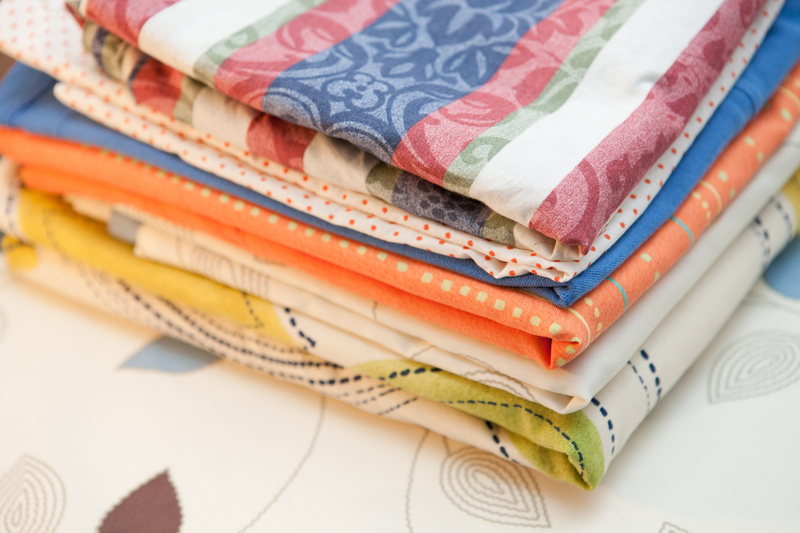Safeguard Your Sofa: Top Storage Strategies
Posted on 23/05/2025
Safeguard Your Sofa: Top Storage Strategies
Sofas are not just furniture--they are investments in your comfort and home aesthetics. Whether you're storing your sofa during a relocation, home renovation, or to save seasonal space, using the right sofa storage strategies ensures it emerges unscathed, plush, and ready to use. Discover expert techniques to protect and maintain your beloved couch with these comprehensive storage solutions.
Why Proper Sofa Storage Matters
Many homeowners underestimate the impact of improper storage on their sofas. A well-cared-for sofa can last for years, while neglect or hasty storage can lead to irreparable damage. From fading upholstery to warped frames or pest infestations, the risks are real but entirely preventable with the right approach. In this article, we'll provide the top storage strategies to protect your sofa so it remains a plush centerpiece in your living space for years to come.

Pre-Storage Sofa Preparation
1. Thoroughly Clean Your Sofa
Storing a dirty sofa is a recipe for disaster. Leftover crumbs, oils, and stains attract pests and accelerate fabric deterioration. Always begin sofa storage with meticulous cleaning:
- Vacuum all surfaces--including cushions, seams, and crevices--to remove dust and debris.
- Use an upholstery-safe cleaner suited to your sofa material. Test in an inconspicuous spot first.
- If your sofa is leather, apply a quality leather conditioner to keep it supple and prevent cracking.
- For fabric sofas, ensure the fabric is completely dry before moving to avoid mildew growth.
2. Disassemble Where Possible
Many modern sofas come with detachable legs, arms, or backs for easy moving and storage. Disassembling your sofa minimizes the risk of damage and makes transportation safer.
- Keep screws, bolts, and other small parts in a labeled zip-lock bag.
- Wrap disassembled pieces securely in bubble wrap or moving blankets.
3. Protect Fragile Elements
Wooden feet, exposed arms, and delicate trims are particularly prone to scratches and dents. Use foam wrap, old towels, or corner protectors to shield these vulnerable sections before storing your sofa.
4. Cover and Shield Upholstery
Never use plastic wrap directly against the sofa fabric; it can trap moisture and cause mold. Instead, use:
- Soft, breathable cotton sheets
- Specialized furniture covers
- Drop cloths
Secure the cover in place with tape or rope (not too tight--you don't want impressions left on the foam).
Choosing an Ideal Storage Space
Optimal Storage Environments for Sofas
Not all storage spaces are created equal. The location you pick can determine your sofa's fate.
- Climate-controlled storage units are the gold standard. They guard your furniture against extreme temperatures and humidity, both major culprits behind frame warping and mold growth.
- If using a garage, basement, or attic, ensure the area is dry, free from leaks, and well-ventilated.
Tip: Always elevate your sofa off the floor using pallets or planks to protect it from unintended water damage.
Evaluate Security and Cleanliness
- Look for storage facilities with 24/7 surveillance, restricted access, and insurance options.
- Inspect for dust, pests, or excessive moisture prior to storing your sofa, as these elements can wreak havoc over time.
Moving and Positioning Your Sofa
Safe Transportation Makes a Difference
When transporting your sofa into storage, use professional movers or at least proper lifting equipment to prevent accidents and avoid straining the sofa's joints and frame.
- Use a dolly or trolley for heavy lifting.
- Keep the sofa upright to prevent padding from shifting.
- Do not drag the couch--this can tear upholstery and damage legs.
- Secure the sofa in your transport vehicle to minimize jostling during the journey.
Ideal Placement Inside Storage
Never stack heavy items on top of your stored sofa. Heavy objects can permanently warp the frame or compress the cushions.
- Arrange the sofa against a wall--leaving a gap for air circulation.
- Store cushions separately (if removable), laid flat, or wrapped in breathable bags to maintain their shape.
Protecting Your Sofa During Long-term Storage
Regular Maintenance Checks
Even when stored, a sofa requires attention. Visit your storage unit periodically to check for:
- Signs of moisture, mildew, or pests
- Sagging covers or cushions
- Displaced covers or storage protection
Address issues right away to prevent long-term damage.
Pest Prevention Tactics
- Use pest-repellent sachets or natural deterrents such as cedar blocks or lavender sachets.
- Avoid storing food or plants in the same storage unit.
Note: Some chemical products can harm fabric or wood, so always choose furniture-safe options.
Special Strategies for Different Sofa Materials
Storage Tips for Leather Sofas
- Apply a pH-balanced leather conditioner before storage to prevent cracking.
- Never store a leather sofa in plastic; use a cotton covering.
- Keep leather away from direct sunlight, which can cause fading or brittleness.
Preserving Fabric Upholstered Sofas
- Use a fabric protector spray to shield against moisture and dust.
- Avoid tightly wrapping fabric sofas, as compression can leave creases that are hard to remove.
Unique Considerations for Sectional Sofas
- Fully disassemble and label each section for easy reassembly.
- Use color-coded bags or tags for storing sectional connectors and hardware.
Expert Packing Materials for Maximum Protection
Here are the best materials to safeguard every inch of your sofa:
- Moving blankets: Thick and cushioned, they prevent scratches and minor dings.
- Corrugated cardboard sheets: Place under legs or arms for additional support and barrier from the ground.
- Bubble wrap: Ideal for legs, arms, and exposed framework (wrapped loosely, not tightly).
- Furniture covers: Used to shield from dust, especially in longer storage scenarios.
- Tape & rope: For securing covers (remember, not too tight).
Common Mistakes to Avoid
- Don't store sofas in damp, unventilated basements or garages. Moisture destroys both wood and upholstery quicker than nearly anything else.
- Never balance other furniture or boxes on your sofa. This can ruin the cushioning and structural integrity.
- Avoid wrapping the sofa in plastic entirely. Plastic suffocates the material and encourages mildew.
- Do not stack sofa cushions vertically for long periods. Lay them flat to prevent deformation.
- Skipping regular checks during storage. Neglecting inspections means problems can spiral unchecked.
Reassembling and Reviving Your Sofa Post-Storage
Steps for a Fresh Unveiling
- Unwrap with care. Slowly remove protective covers and allow the sofa to air for a few hours.
- Reassemble all parts, referring to your labeled hardware bags and documentation.
- Vacuum and disinfect the sofa. Use upholstery spray for freshness, or a light mist of leather cleaner for leather couches.
- If cushions seem misshapen, gently pat and reshape them; allow time to regain their original fluffiness.
Addressing Minor Storage Wear
- If you notice mild odors, sprinkle baking soda on the upholstery and vacuum after several hours.
- For wrinkle removal on fabric, use a garment steamer (not a regular iron) on low heat.

Frequently Asked Questions About Sofa Storage
-
Q: How long can I safely store a sofa?
A: With correct temperature, humidity, and protection, sofas can be safely stored for several years. However, check every 3-6 months. -
Q: Can I store my sofa in a non-climate-controlled space?
A: It's possible for short periods, but for anything over a few weeks, a temperature and humidity-controlled environment is highly recommended. -
Q: Are there risks in stacking sofas to save space?
A: Absolutely. Stacking can deform both the frame and cushions. Always store sofas individually. -
Q: What should I do if I find mold on my sofa after storage?
A: Clean immediately with an appropriate upholstery or leather cleaner. For extensive damage, you may need professional cleaning.
Conclusion: Protect Your Comfort and Investment
Your sofa is more than just a seat; it's a piece of your home's story and a haven for relaxation. By following these expert sofa storage strategies, you can ensure your treasured furniture remains safe, clean, and inviting, no matter how long it's tucked away. Remember, a little preparation and care today means years of comfort and style tomorrow. Safeguard your sofa--and rest assured it will be ready for you whenever you need it.
Need Further Assistance?
For more tailored advice on sofa protection and storage solutions, reach out to local furniture care professionals or specialized storage companies. Investing time and resources into the right storage practices pays off in preserving both the comfort and value of your favorite sofa.







